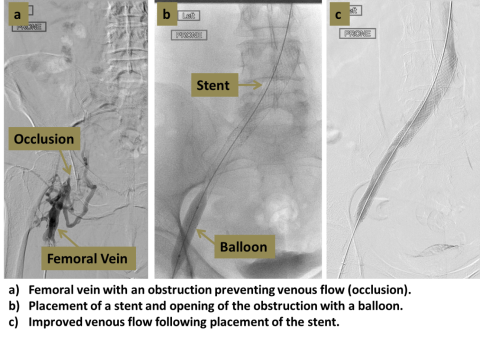Venous thrombolysis and recanalization
Find your care
Our board-certified physicians diagnose and treat many vascular conditions. Call 310-481-7545 to learn more about interventional radiology services.
Venous thrombolysis
Treatment for:
Acute deep venous thrombosis (DVT)
Why it’s done:
Acute DVT (DVT which is less than 2 weeks old) can often be treated with anticoagulation alone. However, in select cases, removal of the offending clot can help improve symptoms and prevent development of post-thrombotic syndrome, which includes pain, swelling, skin changes, and venous ulcers.
How it’s done:
An interventional radiologist uses ultrasound to access the target vein. A small catheter is used to access across the clot, and a clot-dissolving medication is slowly instilled (pharmacologic thrombolysis). In some cases, the clot can be more directly removed using a variety of specialized devices through the same access (mechanical thrombolysis). The procedure may be completed in a single day, or may require several days in the hospital.
Level of anesthesia:
Conscious sedation
Risks:
Bleeding is the main risk, along with pulmonary embolism and infection.
Post-procedure:
Once the procedure is complete, discharge home can usually occur several hours later. Blood thinners and compression stockings are often used to help encourage flow through the vein and prevent recurrent clotting.
Follow-up:
Doppler ultrasound and clinic visit is typically performed several weeks after the procedure to confirm that the vein remains open and that symptoms have improved. Continued follow-up depends on the individual case.
Venous recanalization
Treatment for:
Chronic DVT and chronic venous occlusion
Why it’s done:
Chronic DVT (DVT which is more than 2 weeks old) and other forms of chronic vein occlusion can result in swelling, skin changes and venous ulcers, and may also prevent placement of medically-necessary venous catheters.
How it’s done:
An interventional radiologist uses ultrasound to access the target vein, sometimes at more than one site. Wires, catheters and other devices are used to cross the occluded vein. Balloons, stents and other devices can then be used to re-open the vein and re-establish flow. Sometimes, a clot-dissolving medication may be used to help dissolve any more recent clot. The procedure may be completed in a single day, or may require several days in the hospital.

Level of anesthesia:
Conscious sedation
Risks:
Bleeding is the main risk, along with pulmonary embolism and infection.
Post-procedure:
Once the procedure is complete, discharge home can usually occur several hours later. Blood thinners and compression stockings are often used to help encourage flow through the vein and prevent recurrent clotting.
Follow-up:
Doppler ultrasound and clinic visit is typically performed several weeks after the procedure to confirm that the vein remains open and that symptoms have improved. Continued follow-up depends on the individual case.
For More Information:
For more information or to schedule an appointment, please visit contact us page.